Chinese Journal of Tissue Engineering Research ›› 2014, Vol. 18 ›› Issue (47): 7677-7682.doi: 10.3969/j.issn.2095-4344.2014.47.024
Previous Articles Next Articles
Properties and biomedical applications of shape memory polymers
Zhu Wen-chao, Cui Hai-po, Guo Dan-yi, Xu Yan-kun
- Shanghai Institute for Minimally Invasive Therapy, University of Shanghai for Science and Technology, Shanghai 200093, China
-
Revised:2014-11-01Online:2014-11-19Published:2014-11-19 -
Contact:Cui Hai-po, M.D., Master’s supervisor, Shanghai Institute for Minimally Invasive Therapy, University of Shanghai for Science and Technology, Shanghai 200093, China -
About author:Zhu Wen-chao, Shanghai Institute for Minimally Invasive Therapy, University of Shanghai for Science and Technology, Shanghai 200093, China -
Supported by:the National Natural Science Foundation of China, No. 51305268; Shanghai Innovation Fund Project for College Students, No. 201210252118
CLC Number:
Cite this article
Zhu Wen-chao, Cui Hai-po, Guo Dan-yi, Xu Yan-kun. Properties and biomedical applications of shape memory polymers[J]. Chinese Journal of Tissue Engineering Research, 2014, 18(47): 7677-7682.
share this article

2.1 形状记忆聚合物的性能研究 2.1.1 试验研究 1984年,法国CDF Chimie公司成功开发出世界上首例形状记忆聚合物-聚降冰片烯,后由日本杰昂公司购买专利,并在研究中发现其形状记忆能力[10]。聚降冰片烯是由乙烯和环戊烯催化制得的降冰片烯通过开环聚合得到的双键和五元环交替结合的无定形聚合物,具有形变回复力大、形变速度快、形变回复精确度高的优点;但它的玻璃化转变温度难以调节,而且由于分子量太大加工也比较困难。 1988年,日本三菱重工业株式会社成功开发出热塑性聚氨酯形状记忆聚合物(SMPURs)[10]。其形变回复温度范围广,可在-30-70 ℃范围内调整,此外还具有热塑性、易于加工、形变量大(最高可达400%)、耐气候性和重复形变效果较好等优点,应用前景广泛。2002年,Lendlein等[11]开发了系列可生物降解、适合作药物缓释和牙科、骨科矫形材料的形状记忆聚氨酯。 2001年,为了提高形状记忆聚合物的X射线透过性,减轻其质量,增加舒适性,Steven[12]在以聚己内酯、聚氨酯为基体的医用固定材料中加入一种微球体,该微球体内含有气体,在一定温度下微球会膨胀,从而增强了X射线透过性,减轻质量。其不足之处在于加工比较复杂,而且气体膨胀后,材料内的微小变形会影响其在要求较高场合下的实际使用性能。 聚乳酸、聚己内酯等聚酯类形状记忆材料,除了具有宝贵的形状记忆特性,同时具有良好的生物相容性和生物降解特性,因此在生物医学工程领域具有更为诱人的应用前景[13-14]。2003年,朱光明等[15]通过高能辐射对超高分子量的聚己内酯进行适度处理,获得了具有形状记忆特性的材料,而且达到了消毒目的。该材料的形变回复温度在55 ℃左右,可以应用于人体等低温环境,但由于对降解速率等参数的控制较为困难,故在要求较高的场合使用还需进一步研究。 2004年,Yang等[16]研究发现,当把聚氨酯形状记忆聚合物放入室温下的水中时,它仍然可以回复到其初始形状,即对于聚氨酯形状记忆聚合物,其形状回复的驱动源不仅可以是众所周知的温度,而且可以是湿度的变化。这一发现使研究者可以用一种简单的方法,制作具有功能梯度Tg的形状记忆聚合物。图1是直径为1 mm的聚氨酯形状记忆聚合物丝在水中的形状回复过程。该形状记忆聚合物丝采用挤出工艺制作,其前端放入温度低于Tg的水中,后端保持干燥,然后将其弯成Z型。室温下将其浸入水中,前端首先回复原状,而后端则在后期开始回复原状。"
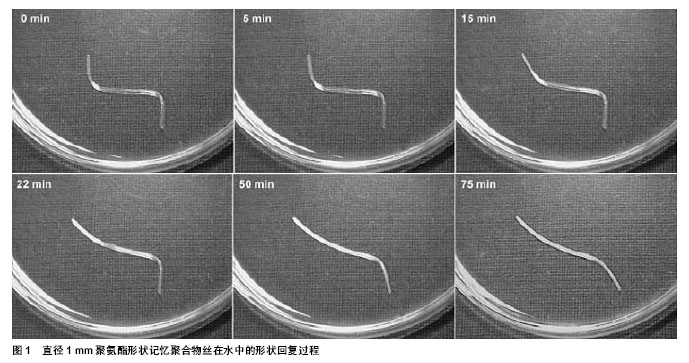
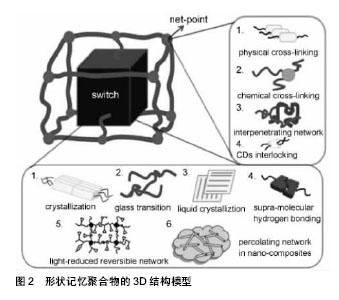
2010年,Xiao等[17]用形状记忆聚己内酯作为药物载体,通过加入聚癸二酸酐,用溶液铸膜法合成了一种具有生物降解性的形状记忆复合材料,该材料的形状记忆特性和生物相容性良好,但用于实际应用仍需进一步研究。 2011年,为了研究形状记忆聚合物的耐久性,确保其在相关环境中能正确发挥应有的功能,Lu等[18]通过高温压痕法评估了形状记忆聚合物在特定环境条件下的性能变化。所模拟的环境包括:将形状记忆聚合物暴露于紫外线辐射中;沉浸在室温下的润滑油中;沉浸在49 ℃水中。结果表明,与无条件限制相比,形状记忆聚合物在限定的环境下通常表现出更低的玻璃化转变温度和更高的应变率敏感性。当形状记忆聚合物的形状回复温度较低时,限定的环境条件将影响其形状回复能力;而当形状记忆聚合物的形状回复温度高于Tg时,其形状回复能力在限定环境条件下保持不变。 2012年,Biju等[19]针对双酚A型二氰酸酯、双酚A二缩水甘油醚及遥爪聚苯酚3种材料,研究了不同成分比例共混物的弯曲性能、动态力学性能和热性能。结果表明,共混物的弯曲强度、储能模量及热稳定性与双酚A型二氰酸酯含量成正比,与遥爪聚苯酚含量成反比。同时,聚合物具有良好的形状记忆性能,且随着遥爪聚苯酚含量的增加,其形状回复率增大,形状回复时间随之减少。聚合物的形状记忆转变温度可通过改变成分比例来调整。该聚合物的环氧树脂系统具有良好的导热、机械和形状记忆特性,因此在智能驱动器应用方面潜力巨大。 2014年,为使电致形状记忆聚合物形状回复的电压控制在较低的水平(在人体安全范围内),Lu等[20]在形状记忆聚合物中添加了碳纳米纤维,并对复合材料的性能进行了研究。结果表明,碳纳米纤维会发生自聚集而形成多层纳米纸,从而使复合材料的电性能得到改善,其形状回复过程可以在30 V的低驱动电压下完成。 2.1.2 理论研究 除上述各种实验研究之外,研究人员还对形状记忆聚合物的性能开展了相关理论分析[21-25]。 黄歆明等[21]运用MSCMarc软件的黏弹性有限元分析功能,对形状记忆聚合物材料的形状记忆过程进行数值模拟。其分析结果与相关实验结果基本吻合,能够准确反映形状记忆聚合物构件的主要性能参数,如构件加载时的应力-应变关系,卸载时的瞬时回复以及形状回复的开始温度和结束温度等。通过有限元分析,能够方便地建立复杂形状记忆聚合物构件和增强形状记忆聚合物材料的有限元模型,为其形状记忆行为的分析提供了一种新的数值计算方法。 李郑发等[22]借鉴聚合物结晶学相关理论,建立了一个针对形状记忆聚合物的新的热力学本构模型,该模型中考虑了形状记忆聚合物冻结和回复过程中的时间延迟、热冻结份数以及机械预应变冻结份数随温度变化的不同趋势,并用细观力学方法确定了材料的等效刚度,通过与已有实验结果比较,二者吻合较好。 2012年,Hu等[24]提出了一种3D形状记忆聚合物的结构模型,如图2所示,它囊括了任意类型的形状记忆聚合物。该模型包括网点和开关相,其中,网点决定形状记忆聚合物的固定形状,开关相则负责临时形状的控制和回复。 2014年,为了对应用日益增加的形状记忆聚合物及其复合材料建立恰当的本构模型,Qiao等[25]基于复合材料桥接模型,建立了单向纤维增强形状记忆聚合物复合材料在热力学载荷下的应力-应变关系矩阵。该模型中考虑了纤维含量和温度的变化以及“冻结应变”的储存和释放。形状记忆聚合物及其复合材料层压板在轴向拉伸载荷下的应力-应变曲线表明,应用该本构模型所得到的理论数据与实验数据基本吻合,故可将该模型应用于工程实践中。此外,该模型也可用于预测在温度变化过程中的应力回复以及应变的储存和释放。"
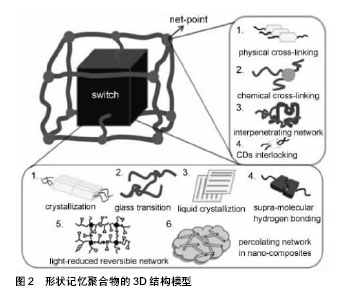
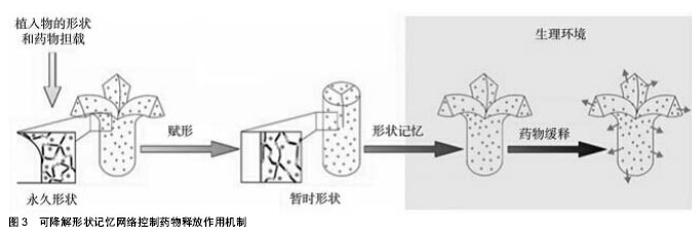
2.2 形状记忆聚合物在生物医学领域的应用 2.2.1 防止血管阻塞器材 形状记忆聚合物可以用于生产各种作为植入物使用的医疗器械,如具有实现血管血液凝块清除功能的微型驱动器[26-28]。美国利弗莫尔国家实验室Monkman等[29]利用形状记忆聚合物制作血栓治疗仪中的关键部件-微驱动器。其制作材料可以是聚氨酯、聚降冰片烯或聚异戊二烯等,先利用注射机将聚合物成型为螺旋形,加热后拉直再冷却定型。装配到治疗系统上后,利用光电控制系统加热,使其回复到螺旋形,就可将血栓拉出。这种方法快捷、彻底,没有不良反应,是治疗血栓的有效途径。 2.2.2 止血钳 将要绑缚的血管末端插入二次成型过的形状记忆材料空腔内,然后通过一定温度的生理盐水使其回复到初始形状,可以紧紧地绑住血管,从而起到止血的作用。如果该形状记忆聚合物材料还同时具有可降解性,则可在治疗完成后自动降解,避免了二次手术。 2.2.3 组织工程支架 近来研制成功的聚氨酯形状记忆聚合物泡沫,通过冷储藏弹性记忆处理进一步扩展了其在医学领域的应用。与实体形状记忆聚合物材料相比,泡沫形状可确保其质量轻,高速展开,高的完整/装载体积比(即最终完全展开的形状与压缩形状之间的体积比)。与实体形状记忆聚合物类似,泡沫体的玻璃化转变温度具有较宽的调整范围,包括稍低于人体体温的37 ℃玻璃化转变温度。由于上述特性,使得聚氨酯形状记忆聚合物泡沫在医学领域有广泛的应用前景。例如,冷储藏弹性记忆处理泡沫结构可以作为组织工程的支架,即作为三维基质支持骨骼在体外及体内的生长。另外,由于冷储藏弹性记忆处理泡沫的Tg及弹性模量均可调节,因此其既可用于软组织工程,也可用于硬组织工程。 将形状记忆聚合物应用于骨组织修复时,若该材料还同时具备生物降解功能,则除了可以实现微创植入外,还能在降解过程中持续施加生物力学刺激,提高对骨缺损的修复和再生功效。Migneco[30]和Neuss等[31]分别报道了可生物降解脂肪族聚酯(聚丙三醇、十二烷酸酯)和具有形记忆特性的聚己内酯二甲基丙烯酸酯网络可作为骨组织支架应用于骨组织修复中的研究。 近年来,电纺丝被广泛用于制备具有高比表面积和孔隙率的纳米纤维支架。与传统的组织工程支架相比,其具有高度仿生天然细胞外基质的结构,并可为细胞提供理想的生存微环境。目前,关于利用形状记忆聚合物结合电纺丝技术制备具有纳米纤维结构的支架,并研究其对成骨细胞生长行为的文献还很少,东华大学包敏[32]用一种新型的形状记忆高分子聚乳酸-聚三甲基碳酸酯(PDLLA-TMC,PLMC),通过电纺丝技术制备具有纳米纤维结构的形状记忆聚合物电纺膜,并评估该多功能纤维支架的成骨能力,为今后开展载药的仿生复合纳米纤维PLMC/HAp用于超声介导的骨缺损修复工作奠定了基础。 2.2.4 在骨折固定中的应用 具有低温形状记忆特性的聚合物,如聚异戊二烯、聚降冰片烯、聚氨酯等,可以代替传统的石膏绷带用作创伤部位的固定材料。将形状记忆聚合物加工成创伤部位形状,对其加热使之软化,之后通过外力将其变形为装配到患者伤处时的形状,冷却定型后装配到创伤部位,再对其加热即可回复到创伤部位形状,从而起到固定作用。再加热软化即可取下,同时其形状记忆触发温度易于调节,使用方便[33]。 脂肪族聚酯类形状记忆聚合物具有可降解性和生物相容性等特性,可用于骨折内固定。麻省理工学院的Langer等[34]报道了用形状记忆材料施行骨折内固定的方法。与外固定方法流程相同,采用可降解的聚乳酸材料,二次成型后装配到带有裂纹的骨髓腔内,用消毒后的热盐水对其加热,聚乳酸材料即可回复到理想固定形状,从而可以与骨髓腔的内表面紧密接触不会滑移,即起到内固定作用。不同的是内固定材料无需取出,最终聚乳酸会被降解吸收而不会对伤口和人体产生危害。Zhen等[35]把具有生物活性及骨诱导活性的羟基磷灰石引入聚丙交酯中,制作成形状记忆聚合物复合材料,作为骨折内固定材料有望能进一步提高治疗效果。 2.2.5 在手术缝合中的应用 手术缝合用形状记忆材料的制备,是在低于其结晶温度但是高于玻璃化温度的条件下,对最初成型的制件进行形变而得到的。对中间过渡状态的环状制件开口,并使其形成与缝合针类似的小钩,这样就可以对手术的切口进行缝合,切口的位置通过形状记忆材料的两端连接起来,然后在热水或热气流的作用下,对其进行加热使其回复至最初的形状,这样手术的切口两端就被紧密的接合在一起了[33]。Lendlein等[11]研究发现聚乳酸等形状记忆材料作为手术缝合线,具有可控的内应力。在使用时以松弛的状态缝合伤口,当温度升高到其形状回复温度时,由于预置的回复力使手术缝合线收紧,从而实现伤口的缝合。随着时间的延长,聚乳酸类形状记忆材料会缓慢降解并被吸收,用这种方法进行手术缝合能够明显降低由于拆线而带来的不便。 2.2.6 在药物缓释中的应用 针对病患部位的理想给药方式是药物能够在患者体内智能释放,具有热-湿效应和pH敏感的形状记忆聚合物凝胶可应用于智能药物释放体系中。如聚N-异丙基丙烯酰胺在温度刺激下溶胀和收缩,可以改变包埋于其中的药物向外扩散的速率,从而实现药物的控制释放[33]。 Christian等[36]采用外消旋乳酸单体/乙二醇共聚的四羟基螯合物与由脂肪族二异氰酸酯合成的聚氨酯共聚,制备可生物降解的热致型形状记忆网状物,并将其作为担载药物的基体。他们给出了可降解形状记忆网络控制药物释放的一种模型,如图3所示。将材料加工成图3中的永久形状,装载药物颗粒后,加热至玻璃化转变温度以上,对其施加外力,使其成为图3中的暂时形状,然后通过微创手术植入到人体病灶部位,在体温的热驱动下发生形状记忆效应,形状回复到起始展开的状态,将药物释放出来。材料可在人体内自行降解,无需二次手术取出。"
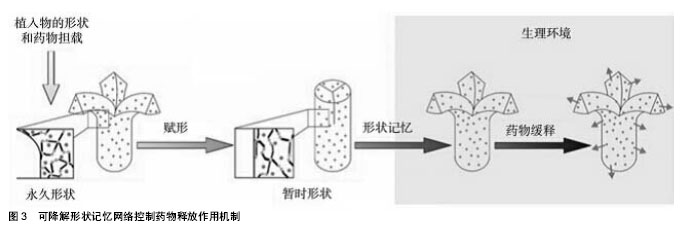
| [1] Hendrik L,Thorsten MG,Byung KK.Novel cationically polymerized epoxy/poly(e-caprolactone) polymers showing a shape memory effect. Polymer. 2012; 53:6089-6095. [2] Chang YW, Eom JP, Kim JG, et al.Preparation and characterization of shape memory polymer networks based on carboxylated telechelic poly(e-caprolactone)/epoxidized natural rubber blends. J Ind and Eng Chem.2010; 16:256-260. [3] Lee HF,Yu HH.Study of electroactive shape memory polyurethane-carbon nanotube hybrids.Soft Matter. 2011; 7(8):3801-3807. [4] Dastgerdi JN,Marquis G,Salimi M. The effect of nanotubes waviness on mechanical properties of CNT/SMP composites. Compos Sci Technol.2013;86:164-169. [5] Jung YC,Yoo HJ,Kim YA,et al.Electroactive shape memory performance of polyurethane composite having homogeneously dispersed and covalently crosslinked carbon nanotubes.Carbon.2010;48(5):1598-1603. [6] Wu TF,Kelly KO,Chen BQ.Poly(vinyl alcohol) particle-reinforced elastomer composites with water-active shape-memory effects. Eur Polym J. 2014; 53:230-237. [7] Gu SY,Yan BB,Liu LL,et al.Carbon nanotube–polyurethane shape memory nanocomposites with low trigger temperature.Eur Polym J.2013;49:3867-3877. [8] Yu K, Liu YJ, Leng JS. Conductive shape memory polymer composite incorporated with hybrid fillers: Electrical, mechanical, and shape memory properties.J Intell Mater Syst Struct.2011;22(4):369-379. [9] 李兴建,王亚茹,郑朝晖,等.形状记忆高分子材料的网络结构化设计和性能研究[J].化学进展,2013,25(10):1726-1737. [10] 杜仕国.形状记忆高分子材料的研究进展[J].功能材料, 1995, 26(2):107-112. [11] Lendlein A,Langer R.Biodegradable elastic shape memory polymers for potential biomedical applications. Science. 2002;296(5573):1673-1676. [12] Steven C.Method for producing a thermoplastic synthetic material provided therewith.US, 6210788B1,2001. [13] Lu HB,Yu K,Sun SH,et al.Mechanical and shape-memory behavior of shape-memory polymer composites with hybrid fillers.Polym Int.2010;59(6):766-771. [14] He ZW,Satarkar N,Xie T,et al.Remote controlled multi-shape polymer nanocomposites with selective radio frequency actuations.Adv Mater.2011;23(28):3192. [15] 朱光明,梁国正.辐照对聚己内酯结构和性能的影响[J].高分子学报,2003,5:667-672. [16] Yang B,Huang WM,Li C,et al.Nano-carbon power filled shape memory polymer. The 1st Int Symp of Nanotechnol. 2004;43: 13-17. [17] Xiao Y,Zhou S,Wang L,et al.Crosslinked Poly(ε-caprolactone)/Poly(sebacic anhydride) composites combining biodegradation, controlled drug release and shape memory effect. Compos Part B: Eng.2010;41(7):537-542. [18] Lu YC,Fulcher JT,Tandon GP.Microscale thermomechanical characterization of environmentally conditioned shape memory polymers. Polym Test.2011;30:563-570. [19] Biju R, Gouri C,Reghunadhan CP.Shape memory polymers based on cyanate ester epoxy poly(tetramethyleneoxide) co-reacted system. Eur Polym J.2012;48:499-511. [20] Lu HB,Liang F,Yao YT,et al.Self-assembled multi-layered carbon nanofiber nanopaper for significantly improving electrical actuation of shape memory polymer nanocomposite. Compos Part B: Eng.2014; 59:191-195. [21] 黄歆明,郑百林,杨青.形状记忆聚合物热致形状记忆行为的有限元数值模拟[J].计算机辅助工程,2008,17(1):30-32. [22] 李郑发,王正道.形状记忆聚合物热力学本构方程[J].高分子学报, 2009,53(1):23-27. [23] Baghania M,Mohammadi H,Naghdabadi R.An analytical solution for shape-memory-polymer Euler-Bernoulli beams under bending.Int J Mechanical Sci. 2014;84:84-90. [24] Hu JL, Zhu Y, Huang HH, et al. Recent advances in shape–memory polymers: Structure, mechanism, functionality, modeling and applications.Prog Polym Sci.2012; 37(12): 1720-1763. [25] Qiao T,Liu LW,Liu YJ,et al.Thermal mechanical constitutive model of fiber reinforced shape memory polymer, composite: based on bridging model. Composites: Part A. 2014; 64: 132-138. [26] Viry L,Mercader C,Miaudet P,et al.Nanotube fibers for electromechanical and shape memory actuators.J Mater Chem.2010;20(17):3487. [27] He B,Li H,Jin K.Shape memory polymer actuated hollow snap-fit design analysis. Mater Des.2013;47:539-550. [28] Sun L,Huang WM.Thermo/moisture responsive shape memory polymer for possible surgery/operation inside living cells in future.Mater Des.2010; 31(5):2684-2689. [29] Monkman GJ.Advances in shape memory polymer actuaction.Mechatronics.2000; 10(4-5):489-498. [30] Migneco F,Huang YC,Birla RK,et al. Poly(glyceroldo decanoate): A biodegradable polyester for medical devices and tissue engineering scaffolds.Biomaterials. 2009;30(33): 6479-6484. [31] Neuss S,Blomenkamp I,Stainforth R,et al.The use of a shape-memory poly(epsilon-caprolactone) dimethacrylate network as a tissue engineering scaffold. Biomaterials. 2009; 30(9):1697-1705. [32] 包敏.具有形状记忆效应的多功能骨组织工程支架的构建研究[D].上海:东华大学,2014. [33] 朱光明,刘忠让.形状记忆聚合物及其在生物医学工程中的应用[J].生物医学工程学杂志,2005,22(5):1082 -1084. [34] Langer R,Lendlein A,Schmidt A,et al.Biodegradable shape memory polymers.WO 99/42147,1999. [35] Zhen XT,Zhou SB,Li XH,et al.Shape memory properties of poly(d,l-lactide)/hyoxyapatite composites.Biomaterials.2006; 27(24):4288-4295. [36] Christian W, Axel TN,Susi S,et al. Evaluation of a degradable shape memory polymer network as matrix for controlled drug release.J Controlled Release.2009; 138(3):243-250. |
| [1] | Pu Rui, Chen Ziyang, Yuan Lingyan. Characteristics and effects of exosomes from different cell sources in cardioprotection [J]. Chinese Journal of Tissue Engineering Research, 2021, 25(在线): 1-. |
| [2] | Zhang Chao, Lü Xin. Heterotopic ossification after acetabular fracture fixation: risk factors, prevention and treatment progress [J]. Chinese Journal of Tissue Engineering Research, 2021, 25(9): 1434-1439. |
| [3] | Zhou Jihui, Li Xinzhi, Zhou You, Huang Wei, Chen Wenyao. Multiple problems in the selection of implants for patellar fracture [J]. Chinese Journal of Tissue Engineering Research, 2021, 25(9): 1440-1445. |
| [4] | Wang Debin, Bi Zhenggang. Related problems in anatomy mechanics, injury characteristics, fixed repair and three-dimensional technology application for olecranon fracture-dislocations [J]. Chinese Journal of Tissue Engineering Research, 2021, 25(9): 1446-1451. |
| [5] | Ji Zhixiang, Lan Changgong. Polymorphism of urate transporter in gout and its correlation with gout treatment [J]. Chinese Journal of Tissue Engineering Research, 2021, 25(8): 1290-1298. |
| [6] | Yuan Mei, Zhang Xinxin, Guo Yisha, Bi Xia. Diagnostic potential of circulating microRNA in vascular cognitive impairment [J]. Chinese Journal of Tissue Engineering Research, 2021, 25(8): 1299-1304. |
| [7] | Wang Xianyao, Guan Yalin, Liu Zhongshan. Strategies for improving the therapeutic efficacy of mesenchymal stem cells in the treatment of nonhealing wounds [J]. Chinese Journal of Tissue Engineering Research, 2021, 25(7): 1081-1087. |
| [8] | Wan Ran, Shi Xu, Liu Jingsong, Wang Yansong. Research progress in the treatment of spinal cord injury with mesenchymal stem cell secretome [J]. Chinese Journal of Tissue Engineering Research, 2021, 25(7): 1088-1095. |
| [9] | Liao Chengcheng, An Jiaxing, Tan Zhangxue, Wang Qian, Liu Jianguo. Therapeutic target and application prospects of oral squamous cell carcinoma stem cells [J]. Chinese Journal of Tissue Engineering Research, 2021, 25(7): 1096-1103. |
| [10] | Zhao Min, Feng Liuxiang, Chen Yao, Gu Xia, Wang Pingyi, Li Yimei, Li Wenhua. Exosomes as a disease marker under hypoxic conditions [J]. Chinese Journal of Tissue Engineering Research, 2021, 25(7): 1104-1108. |
| [11] | Xie Wenjia, Xia Tianjiao, Zhou Qingyun, Liu Yujia, Gu Xiaoping. Role of microglia-mediated neuronal injury in neurodegenerative diseases [J]. Chinese Journal of Tissue Engineering Research, 2021, 25(7): 1109-1115. |
| [12] | Li Shanshan, Guo Xiaoxiao, You Ran, Yang Xiufen, Zhao Lu, Chen Xi, Wang Yanling. Photoreceptor cell replacement therapy for retinal degeneration diseases [J]. Chinese Journal of Tissue Engineering Research, 2021, 25(7): 1116-1121. |
| [13] | Jiao Hui, Zhang Yining, Song Yuqing, Lin Yu, Wang Xiuli. Advances in research and application of breast cancer organoids [J]. Chinese Journal of Tissue Engineering Research, 2021, 25(7): 1122-1128. |
| [14] | Wang Shiqi, Zhang Jinsheng. Effects of Chinese medicine on proliferation, differentiation and aging of bone marrow mesenchymal stem cells regulating ischemia-hypoxia microenvironment [J]. Chinese Journal of Tissue Engineering Research, 2021, 25(7): 1129-1134. |
| [15] | Zeng Yanhua, Hao Yanlei. In vitro culture and purification of Schwann cells: a systematic review [J]. Chinese Journal of Tissue Engineering Research, 2021, 25(7): 1135-1141. |
| Viewed | ||||||
|
Full text |
|
|||||
|
Abstract |
|
|||||